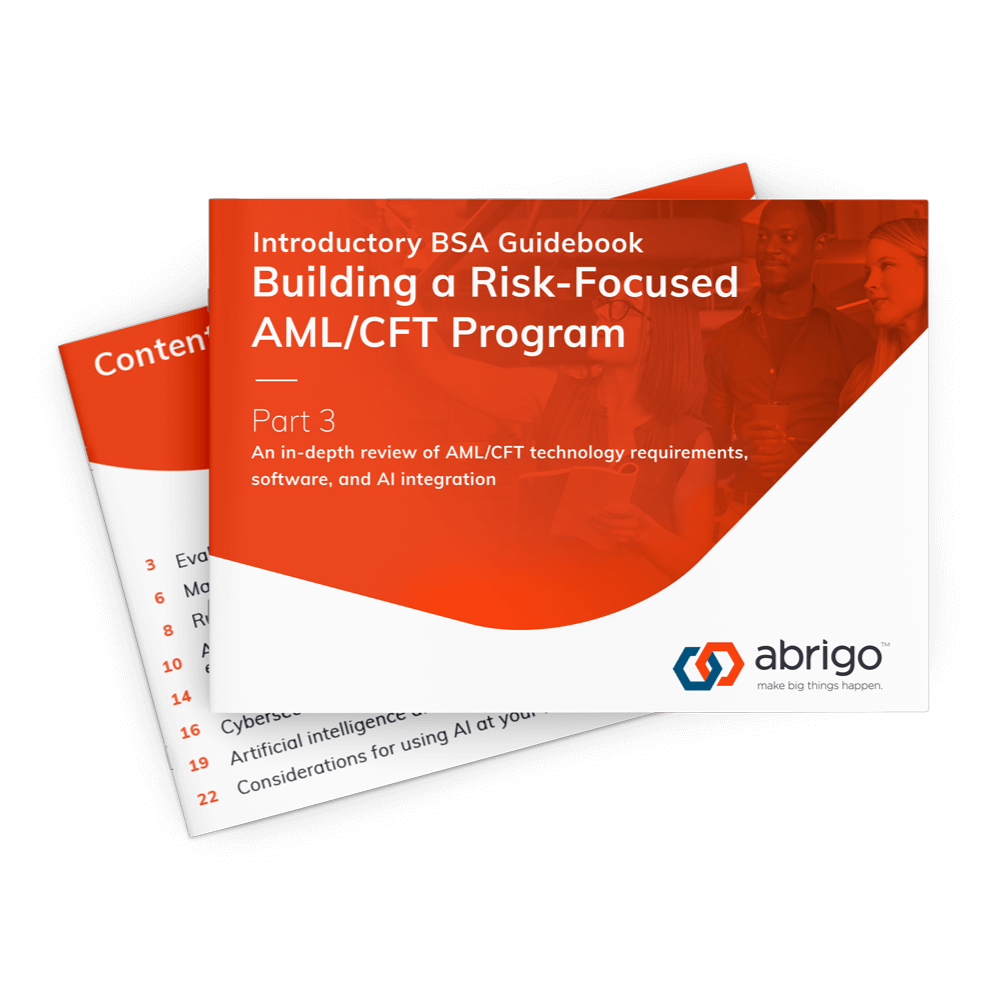This introductory guidebook for AML compliance provides best practices for integrating technology in your AML/CFT and fraud programs, including:
BSA ebook: Building a risk-focused AML/CFT program | Part 3
Building a risk-focused
AML/CFT program
Part 3:
An in-depth review of AML/CFT technology requirements, software, and AI integration
Download this free training guide with best practices for establishing a risk-based AML/CFT compliance program.

Download Part 3 of our AML/CFT program guide
- Change management strategies such as steps for evaluating your current workflow and budgeting for technology
- The difference between rules- and behavior-based analytics and how to find a good balance when detecting suspicious activity
- Creating a testing environment to determine the sweet spot for each scenario and risk rating setting within your AML software.
- Cloud computing and cybersecurity considerations
In this guide:
Optimizing technical resources like AI and machine learning can streamline AML/CFT processes by enhancing efficiency, improving accuracy, and allowing staff to focus on areas of most significant risk.
We outline best practices on many AML/CFT topics. Part 3 covers:
- Evaluating and improving your AML/CFT system, making successful software transitions, and software analytics
- Above-the-line/below-the-line testing and creating a testing environment
- Cloud computing and your financial institution’s data
- Cybersecurity and safeguarding your AML solutions
- Artificial intelligence, its impact on fraud, and using AI at your financial institution
Get a copy of Part 3 of the Introductory BSA Guidebook in your inbox.
Evaluating and improving your AML/CFT system
Ensuring the technology behind your AML/CFT program is used to its fullest capabilities is vital for maintaining a sound compliance program. Taking the first step toward automating your AML/CFT program can be daunting. Use this chapter as a checklist to gauge your program's preparedness to embrace new techology.
Creating an efficient testing environment
One of the best ways to address dynamic and emerging risks is to conduct above-the-line/below-the-line testing to ensure your software operates at its peak efficiency. Above-the-line/below-the-line testing is a statistical exercise that rigorously analyzes transaction monitoring parameters to identify the optimal settings for suspicious activity monitoring for your institution’s unique risk profile.
Cloud computing and securing data
Cloud computing environments allow cloud service providers to segregate and serve multiple clients on a standard set of physical or virtual hardware. Three of the more common cloud service models have different levels of shared responsibilities between provider and client and are listed in this chapter.
Cybersecurity considerations for AML professionals
Banks and credit unions handle sensitive financial data and transactions that affect millions of customers and businesses. They also face constant cyberattacks from hackers who seek to disrupt services or steal money or data. With the right training, banks and credit unions can reduce their own cyber risks and improve customer and member trust.
Artificial intelligence and how to leverage it against financial crime
Artificial intelligence (AI) has become a global game-changer, offering innovative solutions and efficiencies that were once unimaginable. While AI provides tremendous benefits to financial institutions—streamlining operations, enhancing customer experiences, and bolstering security—it also presents new opportunities for criminals. This chapter explores some of the more common AI methods fraudsters use to prey on their victims and how AI can help combat fraud.


